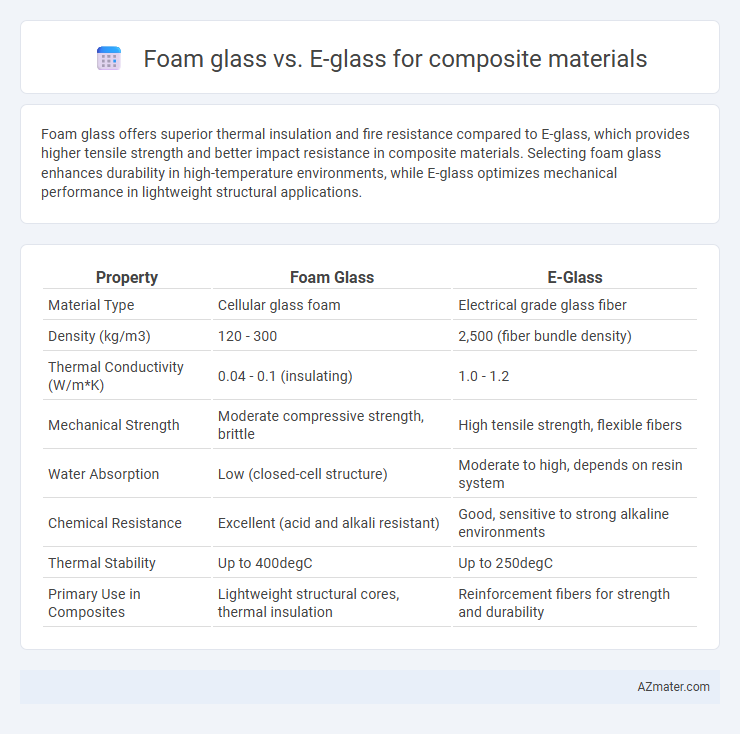Foam glass offers superior thermal insulation and fire resistance compared to E-glass, which provides higher tensile strength and better impact resistance in composite materials. Selecting foam glass enhances durability in high-temperature environments, while E-glass optimizes mechanical performance in lightweight structural applications.
Table of Comparison
| Property | Foam Glass | E-Glass |
|---|---|---|
| Material Type | Cellular glass foam | Electrical grade glass fiber |
| Density (kg/m3) | 120 - 300 | 2,500 (fiber bundle density) |
| Thermal Conductivity (W/m*K) | 0.04 - 0.1 (insulating) | 1.0 - 1.2 |
| Mechanical Strength | Moderate compressive strength, brittle | High tensile strength, flexible fibers |
| Water Absorption | Low (closed-cell structure) | Moderate to high, depends on resin system |
| Chemical Resistance | Excellent (acid and alkali resistant) | Good, sensitive to strong alkaline environments |
| Thermal Stability | Up to 400degC | Up to 250degC |
| Primary Use in Composites | Lightweight structural cores, thermal insulation | Reinforcement fibers for strength and durability |
Introduction to Composite Materials
Foam glass and E-glass serve distinct roles in composite materials, with foam glass providing lightweight, thermal insulation and chemical resistance, while E-glass offers high tensile strength and electrical insulating properties. Composite materials benefit from the integration of foam glass to reduce weight and enhance thermal performance, whereas E-glass fibers improve mechanical durability and structural integrity. The combination of these materials enables advanced composites tailored for aerospace, automotive, and construction industries demanding optimized strength-to-weight ratios and thermal management.
Overview of Foam Glass
Foam glass is a lightweight, cellular glass material characterized by its excellent thermal insulation, high compressive strength, and resistance to moisture, chemicals, and fire. It is produced by fusing glass powders with a foaming agent, creating a rigid structure ideal for insulation and structural applications in composites. Compared to E-glass, foam glass offers superior thermal and chemical stability but lower tensile strength, making it more suitable for insulating and protective layers rather than reinforcement in composites.
Overview of E-Glass
E-glass, a type of fiberglass reinforced with alumino-borosilicate, offers high tensile strength and excellent insulation properties, making it a preferred reinforcement in composite materials. It exhibits superior chemical resistance, thermal stability up to 700degC, and low cost compared to other glass fibers. Widely used in aerospace, automotive, and construction industries, E-glass improves mechanical performance and durability of composite structures without significantly increasing weight.
Key Material Properties Comparison
Foam glass offers superior thermal insulation, lightweight structure, and excellent chemical resistance compared to E-glass, which provides higher tensile strength, greater impact resistance, and improved electrical insulation in composites. The closed-cell nature of foam glass ensures low water absorption and enhanced dimensional stability, whereas E-glass fibers exhibit high modulus and robust fatigue resistance essential for load-bearing applications. Selection between foam glass and E-glass hinges on the specific composite requirements, balancing thermal properties against mechanical strength and durability.
Weight and Density Differences
Foam glass exhibits a significantly lower density, typically around 120-200 kg/m3, compared to E-glass, which ranges from 2500 to 2800 kg/m3, making foam glass a much lighter option for composite materials. The lightweight nature of foam glass enhances thermal insulation and impact resistance, while E-glass provides superior mechanical strength and stiffness due to its higher density and fiber structure. Selecting between foam glass and E-glass depends on the composite's weight-sensitive application requirements and performance criteria.
Mechanical Strength and Durability
Foam glass exhibits superior compressive strength and excellent chemical resistance, making it highly durable under harsh environmental conditions in composite materials. E-glass fibers provide remarkable tensile strength and impact resistance, enhancing the mechanical integrity of composites used in structural applications. Combining foam glass with E-glass fibers results in lightweight composites with balanced mechanical strength and long-term durability suitable for aerospace and automotive industries.
Thermal and Acoustic Insulation Performance
Foam glass offers superior thermal insulation due to its closed-cell structure, providing low thermal conductivity and high resistance to temperature extremes, while also delivering excellent acoustic insulation by effectively dampening sound waves. E-glass fibers, commonly used in composites, provide moderate thermal insulation but excel more in mechanical strength than insulation performance, making them less effective acoustically compared to foam glass. Combining foam glass with E-glass fibers in composites can optimize thermal and acoustic insulation while maintaining structural integrity.
Cost and Manufacturing Considerations
Foam glass offers lower raw material costs and easier recycling processes compared to E-glass, making it a cost-effective option for composite production in large-scale applications. Manufacturing foam glass composites involves simpler thermal foaming techniques, while E-glass requires more energy-intensive fiber drawing and sizing processes that increase production costs. Cost-efficiency of foam glass is favored in thermal insulation composites, whereas E-glass composites are preferred for structural applications despite higher manufacturing expenses.
Applications in Industry
Foam glass offers exceptional thermal insulation and chemical resistance, making it ideal for construction and cryogenic applications, while E-glass excels in mechanical strength and electrical insulation, widely used in automotive, aerospace, and marine composites. The lightweight nature of foam glass reduces structural load in building panels and pipe insulation, whereas E-glass fibers reinforce polymer matrices in wind turbine blades and sporting goods. Industrial sectors leverage foam glass for energy-efficient insulation solutions and E-glass for durable, high-performance composite materials.
Sustainability and Environmental Impact
Foam glass offers superior sustainability through its use of recycled glass and energy-efficient manufacturing processes, significantly reducing carbon emissions compared to traditional materials. E-glass, while widely used in composites, relies on high-energy production and non-renewable raw materials, contributing to a larger environmental footprint. Foam glass's recyclability and minimal off-gassing further enhance its environmental benefits, making it a more eco-friendly choice for composite applications.

Infographic: Foam glass vs E-glass for Composite material
 azmater.com
azmater.com